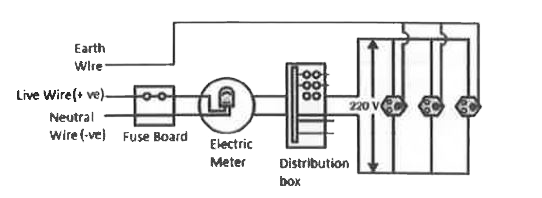Draw a schematic diagram of household/domestic wiring . Give its essential features. Solution in Kannada
Figure : Schematic diagram of domestic electric circuit Its main features are :
Electricity is supplied to our homes either from overhead electric poles or underground wires through mains using two wires. One is the live wire with red insulation cover and the other is neutral wire with back insulation. The potential difference between the two is 220 volts in India .
At the meter board of the house, these two wires pass into electric meter through a main fuse. The fuse is a safety device which cuts of electricity if a high current flows through it.
Through the main switch, the live and neutral wires are connected to line wires of the house which supply electricity of different circuits. The live wire of each circuit is connected to a separate fuse so that if excess current flows, only the electricity in that part of the circuit is cut off and others are not affected.
In any part of the house, all appliances are connected in parallel to each other across the live and neutral wires. This ensures full voltage across each appliance from the mains. Each appliance is provided with a separate switch in its live wire for its operation.
Generally these circuits are divided into heating circuits- which require 15 A current and draw more power (like air conditioners, geysers, etc.) and lighting circuits - which require 5 A current and draw lesser power (like bulbs, fans, etc.)
An additional earth wire with green insulation cover is connected to devices with metal bodies such as toaster, heater, etc. as a safety measure. One end of the earth wire is connected to metal part of the device and the other end is connected to a metal plate buried deep in the ground. Any leakage current in the appliance will then be sent to the earth through earth wire.
The burnt-out fuse should be replaced by another fuse of identical rating because if a fuse of less rating is used then is blows off when normal current is flowing through it and electric appliances shall not work. If the fuse of higher rating is used in case of short circuit or overloading, the fuse would not blow up and excess amount of current may harm the appliances.

Related Playlists
- BOOK - ZEN PUBLICATIONCHAPTER - MAGNETIC EFFECTS OF ELECTRIC CURRENT EXERCISE - Additional question section (Higher-order thinking skills [HOTS] questions)20videos
MAGNETIC EFFECTS OF ELECTRIC CURRENT
- BOOK - ZEN PUBLICATIONCHAPTER - MAGNETIC EFFECTS OF ELECTRIC CURRENT EXERCISE - Additional question section (Short answer [SA] type 2 questions)66videos
MAGNETIC EFFECTS OF ELECTRIC CURRENT
- BOOK - ZEN PUBLICATIONCHAPTER - LIGHT - REFLECTION AND REFRACTIONEXERCISE - ZEN ADDITIONAL QUESTIONS SECTION (LONG ANSWER [LA] QUESTIONS)30videos
LIGHT - REFLECTION AND REFRACTION
- BOOK - ZEN PUBLICATIONCHAPTER - SOURCES OF ENERGYEXERCISE - ZEN ADDITIONAL QUESTIONS SECTION (HIGHER-ORDER THINKING SKILLS [HOTS] )14videos
SOURCES OF ENERGY
Similar Questions
Which of the following is true ?
01:33View SolutionMention some uses of electromagnets .
03:29View SolutionDraw ray diagrams showing the image formation by a concave mirror when an object is placed.
(a) between pole and focus of the mirror
(b) between focus and centre of curvature of the mirror
(c ) at centre of curvature of the mirror
(d) a little beyond centre of curvature of the mirror
(e ) at infinity04:28View SolutionState the areas where acid rains are most likely.
02:12View SolutionDiscuss the main features of a domestic wiring system with the help of a diagram.
04:40View Solutionरेडियो संचार व्यवस्था का योजनाबद्ध ब्लॉक आरेख बनाइये।
04:45View SolutionDraw a schematic sketch of a cyclotron. Explain, giving the essential detail of its construction, how it is used to accelerated a charged particle.
View SolutionDraw a schematic diagram of RNA(clover leaf model)?
View SolutionDraw the schematic diagram of a Cassegrain telescope.
03:22View SolutionGive the principle of cyclotron and draw the neat labelled schematic diagram of cyclotron.
02:15View SolutionDraw a schematic labelled diagram of domestic electric circuit.
04:45View SolutionDraw a schematic diagram of a reflecting telescope (Cassegrain). Write its two advantages
08:44View SolutionDiscuss the main feature of a domestic wiring system with the help of a schematic diagram of one of the common domestic circuits .
02:27View SolutionDraw a Schematic diagram of blood supply to kidney.
03:26View SolutionGive the principle of cyclotron and draw the neat labelled schematic diagram of cyclotron.
04:45View Solution

